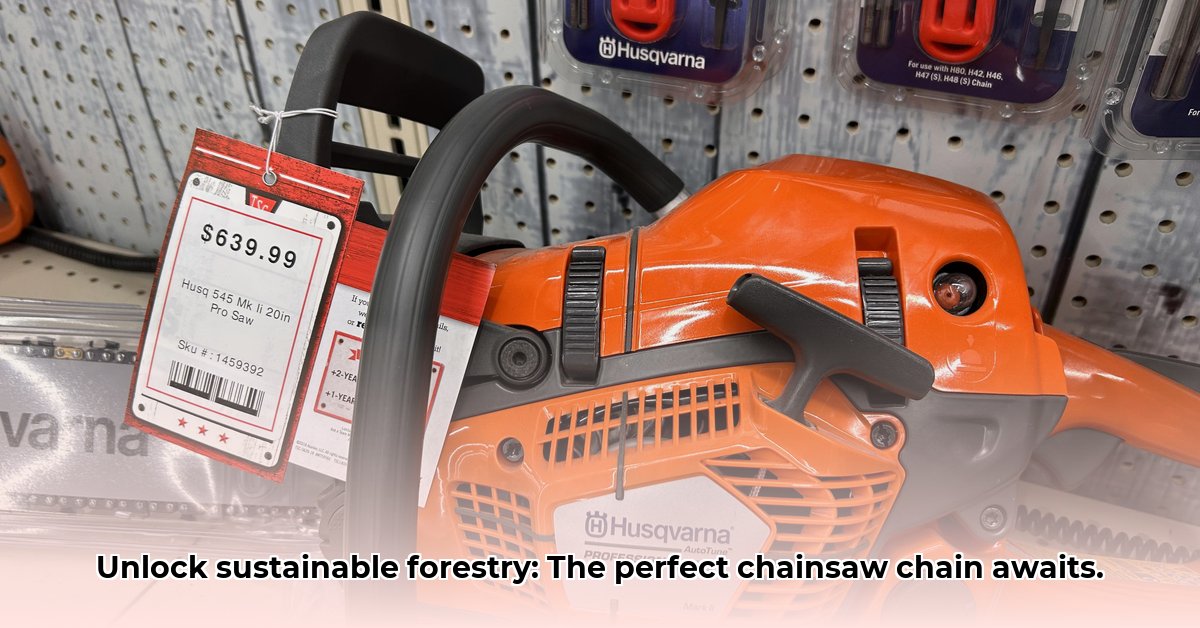
Finding the right chainsaw chain is crucial for efficient and environmentally responsible logging. This guide helps you select, maintain, and use chainsaw chains effectively, maximizing performance while minimizing environmental impact. Whether you're a seasoned logger or a weekend warrior, these tips from Tractor Supply will ensure safe and sustainable forestry practices. For more information on chainsaw chains, check out this helpful resource: Tractor Supply Chainsaw Guide.
Choosing the Right Chainsaw Chain at Tractor Supply
Before heading to Tractor Supply, consider your project. Are you felling large hardwoods or trimming smaller branches? This determines the type of chain you need. Hardwoods, like oak and maple, require durable chains built to withstand tough cutting. Softer woods, like pine, require a different approach. Remember, using the wrong chain size for your chainsaw can lead to damage or dangerous kickback.
Decoding Chainsaw Chain Specifications
Tractor Supply offers various chains from reputable brands. Understanding the specifications on the packaging is vital:
Gauge: This indicates chain thickness. A lower gauge (e.g., .050") cuts faster but wears more quickly. A higher gauge (e.g., .063") is more durable but slower. Think of it like choosing between a scalpel and a butcher knife.
Pitch: The distance between drive links. Smaller pitch means more teeth for precise cuts, ideal for trimming. Larger pitch, fewer teeth, better for felling larger trees. This impacts the cutting speed and agressiveness.
Length: Crucially, the chain must match your chainsaw bar's length. Incorrect length leads to significant problems. Always double-check your chainsaw's manual.
Don't hesitate to ask Tractor Supply staff for assistance; they can guide you towards the best option for your needs.
Matching Chains to Specific Tasks
Different chains excel at different tasks. Consider these options:
| Chain Type | Ideal Application | Pros | Cons |
|---|---|---|---|
| Full Skip Tooth | Larger diameter trees, hardwoods | Aggressive cutting, fast cutting speed | Can cause more vibration, higher wear |
| Semi-Skip Tooth | Medium-diameter trees, varied wood types | Good balance between cutting speed and smoothness | Slightly slower than full skip tooth chains |
| Chisel Tooth | Smaller trees and precise cuts | Very precise cuts, excellent cross-cutting | Can be slower, more sensitive to dulling |
Choosing the correct chain ensures efficient cutting, minimizing fuel consumption and reducing environmental impact. A dull chain can lead to increased fuel use, damaging emissions, and wasted materials. What are the most significant factors you will consider when choosing a chainsaw chain?
Maintaining Your Chainsaw Chain for Optimal Performance and Longevity
Regular maintenance is key to extending chain life and ensuring safety. Neglecting maintenance can lead to dangerous kickbacks and damage the chainsaw.
Sharpening: A dull chain is inefficient and dangerous. Regular sharpening using a file (or professional sharpening services) improves cutting efficiency, and reduces the risk of kickback. Sharpening your chain is a critical safety step that significantly improves performance and safety.
Lubrication: Adequate bar oil lubricates the chain reducing friction and wear. Check your oil level before each use. Proper lubrication extends both chain and bar lifespan. How often do you check and lubricate your chainsaw's chain?
Tension: A properly tensioned chain moves smoothly; too loose, and it can detach; too tight, and it damages the bar and chain. Consult your chainsaw's manual for correct tension. Consistent tension prevents damage and prolongs lifespan.
Cleaning: Remove sawdust and debris after each use. This buildup hinders performance and can damage the chain. A clean chain is a happy, efficient chain.
Sustainable Logging Practices: Minimizing Environmental Impact
Sustainable forestry prioritizes responsible resource use. These practices are crucial:
- Gear Up: Always wear safety glasses, hearing protection, gloves, and chainsaw chaps to protect yourself. Safety is non-negotiable.
- Safe Cutting Techniques: Learn and use proper felling techniques to minimize damage to surrounding trees and the environment. Mastering proper cutting techniques preserves the forest ecosystem and promotes efficient harvesting.
- Responsible Disposal: Dispose of worn chains responsibly according to local regulations. This demonstrates environmental stewardship and complies with regulations.
Remember, selecting the right chain from Tractor Supply, coupled with proper maintenance and safe logging practices, is vital to sustainable forestry.
Your Action Plan: Sustainable Forestry Starts Now
Choosing the right chainsaw chain from Tractor Supply is a significant step towards responsible logging. Take the time to consider the type of wood you're working with, the size of the trees, and the specific task at hand. By combining the right chain with proper maintenance, and safe logging practices, you can minimize the environmental impact of your chainsaw use and maintain a robust and productive forest ecosystem. Visit your local Tractor Supply today and equip yourself for sustainable forestry!